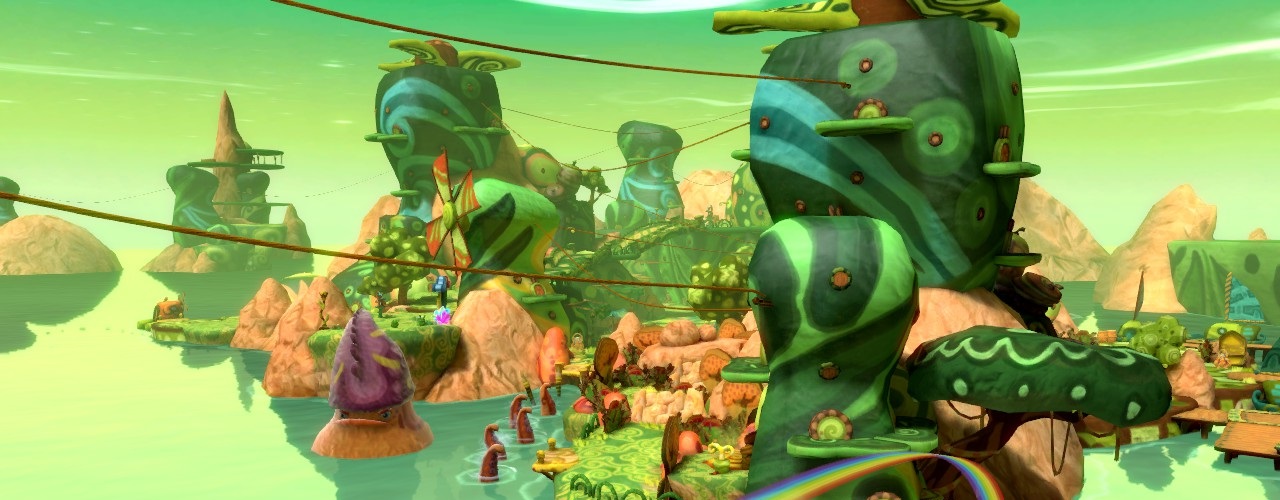So many games these days are obsessed with drab grays and browns that it’s refreshing to come across a game that makes use of the whole color spectrum.
The Last Tinker is one such game. From start to finish, its vibrant palette ensures that the game is a riot of color, while its gameplay hearkens back to classic adventures such as The Legend of Zelda.
You play as Koru, a young monkey who sets off on a quest to unite various factions in the world and restore color to the universe. Along the way you’ll engage in some light platforming, puzzle-solving and simple combat, as you hunt down various spirits to aid you in your journey.
Taking the form of an action-adventure with a simple combat system, The Last Tinker is light on challenge throughout its 6-8 hour running time, but it has more than enough charm to make it worth your while. While the game’s visuals are certainly striking, it also has a fantastic musical score, ranging from folk tunes to orchestral pieces, depending on the area you find yourself in. Voice acting is entirely absent - taking a leaf out of Zelda‘s book, characters are entirely mute - but there are some whimsical sound effects which add personality to each of the game’s characters.
Dialogue is relayed via cardboard cut-out speech bubbles, and the script contains enough humor and warmth that you’ll genuinely come to love the small cast and their interactions with each other as you play through the various levels.
The cast’s personality is only enhanced by some wonderful character design and animation work, that will have you grinning from ear to ear. One character - a walking mushroom who forms the basis of many of the game’s puzzle solutions - sticks in the mind long after completion. He’ll stamp his feet, cry his eyes out in despair, or bound along behind you with child-like glee as you lead him through the world. Every character has been lovingly designed, and you’ll come to adore all of them.
the main story is relatively short and linear. You’re rail-roaded in a particular direction, and it’s always clear what your current goal is. If you ever do become lost, you’re able to activate a breadcrumb trail which will lead you to your destination. Such instances are rare, however, and while a couple of sections do frustrate - an early stealth section springs to mind - much of the game is pretty simple, and shouldn’t provide too much of a challenge.
While the main story is a little on the easy side, previously-completed levels can be returned to. Each contains a number of hidden paintbrushes to be found. It’s not exactly Metroid, but returning to previous areas allows you to find some secrets that you weren’t able to reach before.
Combat starts off relatively simple, but you’re provided with more options as you progress. You’ll finish the game with 3 color-based attacks, each of which have a different emotional effect on the enemy. Hit a foe with a green attack and they’ll run away from you in terror; hit them with a blue attack, and they’ll be stunned by a sudden wave of despair. You can also unlock more moves and combat upgrades as you go on, paid for with gems which drop from foes and destructible objects littered throughout the world. It’s not hugely tactical - and some encounters can be frustrating due to the number of enemies you need to tackle at once - but there’s enough variety in your options that it generally remains satisfying.
The game also provides variety both visually, and in terms of your tasks. Each area is distinct from the last and has its own atmosphere, while mission objectives vary. One section sees you conducting an orchestra, while another will have you undertaking some light detective work, attempting to identify a saboteur. It doesn’t provide the same level of genre mash-up seen in a game like Nier, but it does mean that things remain fresh for the most part.
The game’s platforming mechanics are fairly basic; there’s no jump button, and while some of the environments are fairly expansive they’re also fairly restrictive in terms of how you navigate them. While the game certainly looks good - and it really does - we couldn’t help but feel that perhaps a more open design approach would have benefited The Last Tinker. It feels like a game which wants to provide you with a large open world to explore, but one which also isn’t certain about how to go about it. It’s crying out for a more Metroidvania approach, while loading screens between each area means that the world is never quite as cohesive as you’d hope it would be.
Still, none of that detracts from the fact that The Last Tinker is still well worth your time. It’s gorgeous to look at, it sounds great, and it’s certainly fun to play. It’s a pleasingly old-school approach to game design that doesn’t always pay off, but is never less than enjoyable.


